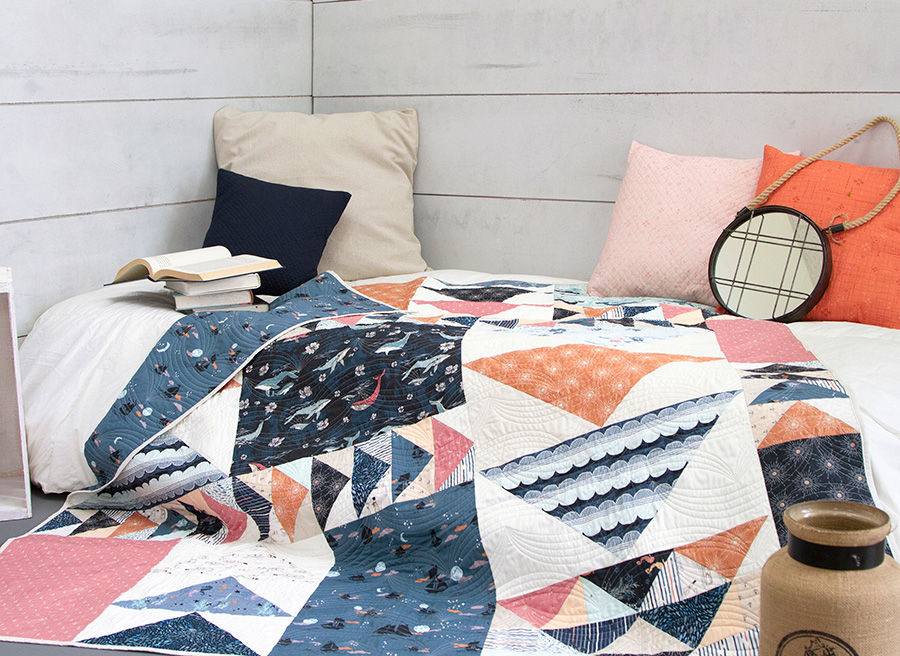Contents
What is the difference between patchwork and quilting?
In patchwork, small pieces of fabric are sewn together to form a larger textile. These pieces of fabric can be of different materials and sewn in different shapes and sizes. Thus, the term patchwork refers to a technique rather than a finished work or an object such as a blanket.
To make a quilt, you first create what’s called a quilt sandwich of quilt top (usually a patchwork), batting, and backing fabric (often from a single large sheet of fabric) and stitch through it all (the quilting) so it will hold together later. So the quilt is the finished object, usually a blanket.
When did patchwork and quilting come into existence?
Patchwork and quilts have a long history that spans thousands of years – the oldest works known to us are over 3000 years old. However, this early textile craft was different from the quilts we know today, as it was made mainly from wool or leather, rather than the cotton we use today.
Patchwork existed on all continents and the partly completely different development is more than exciting and still gives us new impulses today. I would like to mention here for example Hawaiian quilts , Korean quilts and Japanese Yosegire quilts.
Our gaze is always directed to America, because there quilts are incredibly popular and can be found in almost every home. In many small towns there are fabric stores and patchwork is part of everyday life there. Nevertheless, patchwork has a much longer history in Europe than in America. The technique of sewing small pieces of fabric together to make a large work was used in Europe as early as the Middle Ages to save and utilize precious fabrics and, of course, to recycle old used textiles. However, these early patchwork projects were usually smaller than the quilts we know today and were mainly used for small items like pillows and bags.
Over the centuries, the technique has evolved in Europe and there have been waves of popularity – for example, in the 18th century patchwork became popular in England and France as a fad and there were many ladies who made patchwork and quilts.
Different European countries have developed their own traditions and styles, such as the technique of “English Paper Piecing” (EPP), which involves shaping pieces of fabric around templates, or French “Crazy Quilting,” which involves sewing pieces of fabric together in irregular shapes, often decorated with embroidery and borders.
In the 19th century, however, this popularity waned as machine-made fabrics became cheaper and more readily available in the wake of industrialization. Patchwork, however, remained in Europe an applied technique of recycling scraps.
The history of patchwork in America began in the 17th century, when the first European settlers brought with them their knowledge of sewing and began to rework all sorts of scraps of fabric and old clothing. New fabrics were scarce and very expensive, so a good use of leftovers was very important.
Over the centuries, patchwork and quilting have continued to evolve and change, and today there are many different types, ranging from handmade traditional quilts to machine-made modern blankets.
In recent decades, quilting has experienced a true renaissance, becoming a popular pastime and a sometimes museum art form with modern and abstract designs.
Both traditional techniques such as hand quilting, English paper piecing and applique, and modern techniques and tools such as sewing machines and computer-aided design are used.
Why is sewing patchwork and quilts so much fun?
Sewing patchwork and quilts offers us endless opportunities to be creative while creating a meaningful sewing project. Some of the reasons why sewing quilts are fun:
- Creativity: When sewing patchwork and quilts, you can combine colors, patterns and textures to create a unique and individual project. Colors, shapes, fabric type and yarn are the key features here.
- Relaxation: Sewing quilts can be a meditative experience that helps you to immerse yourself deeply in a piece of needlework and to de-stress and relax.
- Fulfillment: Finishing a quilt is a wonderful feeling because you have created a handmade piece that you can be proud of and use.
- Community: Meeting in quilting groups to share experiences and to support and inspire each other makes our wonderful hobby even more fun and creates a strong sense of community.
- Tradition: Quilting has a long tradition and is an important part of the culture of many countries. It is also a way to preserve and pass on the history and culture.
What material is needed for patchwork quilts?
- Fabrics (see my article about real patchwork fabrics)
- Fleece (you can find high-quality fleece here)
- Yarn (and here you can find Aurifil yarns)
What tools are needed for patchwork and quilting?
Which tool to use for this beautiful needlework depends on personal preferences on the one hand, and on the technique you want to use on the other.
For a machine sewn quilt, you will need a sewing machine, preferably with a large throat and a mountable top feed foot, a straight stitch plate and a retractable bottom feed, should you want to do Free Emotion Quilting and Ruler Quilting.
For a hand sewn quilt you will need sewing and quilting needles, thimbles and quilting ring.
For both types, the layers of the quilt sandwich are secured before quilting using either basting thread, bent safety pins, pins or spray adhesive.
You will find a large selection of material and work train in my store – if you have any questions, just contact me by WhatsApp at 0171 3589754, by email at info@laridae-quiltingshop.de or by phone at 04893 373928.
